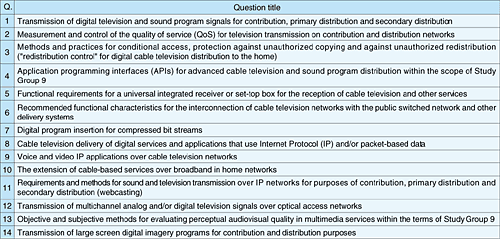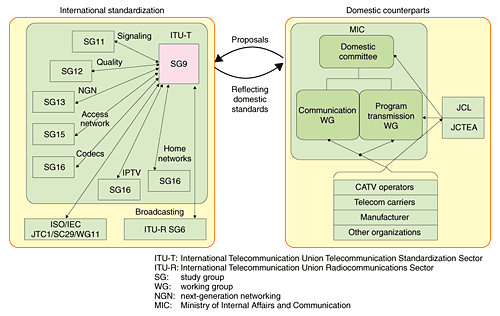 |
|||||
|
|
|||||
|
Global Standardization Activities Vol. 5, No. 4, pp. 47–51, Apr. 2007. https://doi.org/10.53829/ntr200704gls Activities of ITU-T SG9AbstractThis article describes the recent activities of ITU-T SG9 related to CATV (cable television) together with some interesting topics related to its circumstances. CATV has been isolated from the telecommunication world until recently. The recent upheavals in telecommunication and broadcasting, including CATV, which are being driven by technical innovation and deregulation, are softening the boundaries between the two worlds.
1. IntroductionITU-T SG9 [1], one of the Study Groups of ITU-T (International Telecommunication Union Telecommunication Standardization Sector), is responsible for integrated cable networks. Its mandate also includes cable modems, multimedia service platforms for cable television (CATV), set-top boxes (STBs), application programming interfaces (APIs) for broadcasting services, methods for evaluating audiovisual quality, home network, and Internet Protocol (IP) broadcasting. SG9 meetings usually have about 50 participants. Some of these come from the broadcasting industry or related fields, i.e., from outside the telecommunications field. The strong relationship with the broadcasting industry is a unique feature of SG9. For many years, ITU-T SG9 has maintained a close relationship with ITU-R SG6, which is responsible for broadcasting technologies. The latest broadcasting technologies such as large screen digital imagery (LSDI) and APIs are being discussed. In addition to broadcasting, SG9 has developed a number of recommendations in areas such as cable modems and multimedia service platforms for CATV. Among them, cable modems are known as one of the most successful activities of SG9. Most existing CATV technologies were developed by CableLabs in the USA or are based on the technologies developed by it. ITU-T adopted and ratified DOCSIS (data over cable service interface specifications) as ITU-T Recommendations and it is virtually the only global standard in this area. It is being used in many countries including Japan. Japanese CATV operators mostly use imported technologies like DOCSIS cable modems, which means that they are weak at developing their own technologies that meet not just the technical requirements but also business demands. Coordination between international standardization bodies such as ITU-T SG9 and domestic R&D and standardization bodies is recognized as an important goal by the Japanese CATV industry. For this purpose, the domestic activities corresponding to SG9 have been reinforced by the establishment of two Working Groups that are responsible for more specific issues. These Working Groups support the decision-making activities of the domestic committee for SG9. NTT is deeply involved in this activity and continues to contribute in this area. There are some private organizations working in this area. JCTEA (Japan Cable Television Engineering Association) and JCL (Japan Cable Laboratories) are private standardization organizations in this area. These organizations collaborate with ARIB (Association of Radio Industries and Businesses), a private standardization organization focusing on broadcasting and radio communication. The technical coordination that yielded STB specifications and the development of a system for the retransmission of digital broadcasting are successful examples of this collaboration. These organizations are also responsible for coordinating international and domestic standardization activities. Although these activities do not directly benefit our business, NTT is strongly expected to play a leading role in this area as a leader in telecommunication technologies. 2. Study itemsSG9 has 14 Questions, which are responsible for more specific study items (Table 1). NTT continues to take responsibility as a Rapporteur as well as to promote standardization activities with several contributions. The major topics of SG9 are briefly discussed below. Table 1. Study items of SG9.
2.1 IPCablecomIPCablecom, discussed in Questions 6 and 9, is the SG9 project intended to give multimedia capability to CATV systems by combining cable modems and IP technologies. IPCablecom currently supports, mainly, telephone service (VoIP (voice over IP)) through the use of MGCP (media gateway control protocol) signaling. Coordination activities were made taking into consideration the emerging technology of SIP (session initiation protocol). The latest version of IPCablecom, IPCablecom2, is now under development. IPCablecom2 based on the IMS (IP multimedia subsystems) of 3GPP (3rd Generation Partnership Project) is expected to enhance multimedia aspects beyond conventional telephony. 2.2 Cable modemsCable modems, being discussed in Q.8, are increasingly becoming important as a way to provide an interactive capability in an integrated CATV service. Early cable modems were built on proprietary technologies. Cable modems from different manufacturers offered only limited commonalities such as RF (radio frequency) modulation. Regional and international standards were developed under the leadership of Cable Television Laboratories and ITU-T SG9. After the successful completion of DOCSIS 1.0, which enabled interoperability among cable modems from different manufacturers, the standardization efforts for DOCSIS 1.1 continued. DOCSIS 1.1 enhanced QoS (quality of service) capability and DOCSIS 2.0 improved physical layer functionality, such as by providing symmetrical transmission and noise resiliency. Currently, new specifications, called DOCSIS 3.0, are under development. Using the new transmission architecture called "channel-bonding", which enables multiple physical channels to be used as a single transmission pipe, DOCSIS 3.0 is expected to provide a high bandwidth equivalent to FTTH. 2.3 Network transportQuestions 1, 7, and 12 cover the study items related to network transmission of video signals. Some examples of recent topics in this area are analog and IP transmission of multichannel video signals over an optical fiber network, reliable IP multicasting, and free viewpoint TV (FTV). Multichannel video transmission over an optical fiber network is a study item of Q.12, where NTT has taken a leadership role as a Rapporteur. IP transmission technology applicable to the retransmission of digital broadcasting is going to be developed. This study item resulted in J.281 and J.282, which describe requirements and a system architecture, respectively. The development of technical specifications is expected. Since this topic requires a sufficient level of understanding of access networks, collaboration with SG15, which is the lead study group for access networks, is considered to be important. Furthermore, a liaison relationship is being maintained with FG-IPTV, which is responsible for the development of IPTV specifications, as well as gap analysis. 2.4 Conditional access and webcastingWebcasting discussed in Q.11 is a kind of IP-based video delivery technology. Recent activities include electronic news gathering (ENG) over the IP network. The conventional activities of IP-based broadcasting systems generally focus on IP-based distribution or interactive capability. However, ENG, which carries video signals from event venues to the broadcasting station or studio for example, plays an important role in the broadcasting system. The conditional access system (CAS) is a mechanism for controlling the viewing of a broadcast program and is a study item of Q.3. It involves mechanisms such as encryption and key management, both of which have been partly standardized. Unfortunately, conventional CASs are based on proprietary technology or regional standards and disclosure is only partial to maintain confidentiality. Since CAS is an important technical component, it is recognized as one of the barriers to international interoperability among terminal devices. Technology is changing the situation. Conurable D-CAS (downloadable CAS) could implement various CASs and is considered to be a way toward a solution. The study will progress with consideration of digital rights management (DRM) systems. 2.5 Quality assessmentA methodology for video quality assessment is being advanced in SG9. Video quality assessment is used in various applications and systems including broadcasting and CATV. There are several existing schemes such as full-reference, reduced-reference, and non-reference. All these schemes are covered by SG9. It is expected to produce industry-usable technology. 2.6 APIsThe digital broadcasting service is being enhanced to offer improved interactivity and multimedia capability. For this, the API plays an important role. Considering the retransmission business, which is a primary function of CATV, it is natural for SG9 to take APIs seriously. API discussion in SG9 has two aspects: program exchange with other broadcasting networks and enhanced interactivity. For the former, SG9 has promoted coordination efforts with ITU-R SG6, which is responsible for the standardization of broadcasting technology. For the latter, SG9 is considering the API technology developed for the cable industry. The current recommendations, J.200, J.201 and J.202, cover all major API standards including BML (broadcast markup language), MHP (multimedia home platform) and OCAP (open cable application platform). Among them, BML is an API standard used mainly in the Japanese broadcasting industry. SG9's efforts will continue to keep up with the development of new features. 2.7 LSDILSDI is an emerging video technology that provides higher video image quality than the convention television service. Since cinema, not TV, was considered to be a possible application of LSDI, this technology used to be referred to as Digital Cinema. In the same way that high definition television (HDTV) had a substantial impact on the broadcasting industry, LSDI is expected to act as a strong impetus to the development of future broadcasting technology. The standardization activities for LSDI are mainly being performed by a forum called DCI (Digital Cinema Initiatives). Some ITU SGs are following its activities and have developed recommendations. SG9 is focusing on the network transmission aspects with regard to television transmission. The study of digital cinema is now considered to be at an early stage. There needs to be more effort for a complete set of technical specifications. 2.8 STBs and home networksThe end user's CATV system is responsible for almost all aspects of the user's experience, for example the presentation of audio/video programs and data content, copy protection, interactivity, content searching and navigation, and billing. Hence, its standardization involves a wide range of topics. Q.5 is responsible for this difficult task. In any standardization activity, it is generally desirable to define the specifications in detail in order to avoid interoperability problems due to misunderstandings. However, writing the STB specifications in too much detail may cause another problem. If the specifications define technical points that are unrelated to interoperability, they may inhibit the emergence of innovative products that would be welcomed by the consumer. On the other hand, it is difficult to identify which technical issues do not affect interoperability with outside systems and are not regarded as important items. One example of this issue is the design of the remote controller. Selecting relevant topics and defining the appropriate depth of the specifications is a key point in activities in this area. SG9 considered the above situation when developing STB architecture recommendations, J.290, J.291, and J.292. These recommendations deal with the architecture of the next-generation STB. A study of detailed technical specifications is expected to start shortly. Home networks are also being studied in SG9: this topic is covered by Q.10. SG9 has a strong interest in AV (audio/visual) transport and interaction with cable networks. Home Network architecture J.190 was developed in 2002 and has been continually studied since then. Activities in this area are progressing in consultation with JCA-HN, which is responsible for the total coordination of home networks within ITU-T. 3. SG9 Tokyo MeetingAn SG9 meeting was held in Tokyo in October 2006. Nearly 100 participants from 6 countries (China (People's Republic of), France, Korea (Republic of), Japan, the UK, and the USA) gathered at this meeting. The US CATV industry has led the activities of SG9 with their advanced technologies and business strategies. However, their Japanese counterparts are rapidly catching up, as can be seen in the substantial change in business environment such as the formation of multi-system operators (MSOs) and the establishment of Japan Cable Laboratories, which acts as a center of excellence for CATV technology. The meeting in Tokyo was a good opportunity for industry leaders on both sides of the Pacific to meet and exchange views on the future of CATV. A wide range of topics, as mentioned above, were discussed and 30 draft recommendations were approved. This meeting was supported financially and logistically by more than 40 organizations. NTT supported this meeting as a Platinum sponsor. 4. ConclusionThe broadcasting industry, including CATV, has been isolated from the telecommunication industry for a long time. Recent technical advancements, such as conversion from analog to digital technology and changes in the business environment have created a new and unique opportunity for both industries. SG9 is working in the area where the communication and broadcasting industries overlap. International standardization should given more attention as one of the key technical foundations. References
|
|||||










